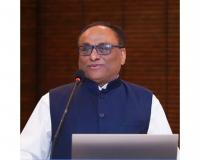Future Trends and Predictions in Gold Trading- Alex Volkov, Market Analyst at VT Markets

New Delhi [India], December 03: As we progress further into the 21st century, gold continues to symbolize wealth and serves as a dependable means of preserving value, especially during uncertain economic times. The landscape of gold investment has transformed, largely due to technological advancements. Many investors now prefer digital options over traditional physical gold, turning to solutions like digital gold and exchange-traded funds (ETFs). ETFs offer numerous benefits, including liquidity, diversification, lower fees compared to mutual funds, tax efficiency, ease of trading, and the ability to gain gold exposure without owning it physically. These modern alternatives provide greater flexibility and appeal especially to younger investors who appreciate the convenience of digital transactions. Additionally, fractional ownership allows individuals to purchase smaller amounts of gold, making it more accessible.
Meanwhile, artificial intelligence (AI) is also helping in revolutionizing gold trading. By analyzing vast amounts of market data, AI can identify trends and predict price fluctuations with greater accuracy. Automated trading systems powered by AI execute trades quickly, thereby enhancing efficiency and increasing returns for users. Additionally, global conflicts or uncertainties also significantly influence gold demand; where investors can often turn to gold as a “safe haven” asset. This behavior highlights gold’s enduring value in challenging economic climates, reinforcing its role as a reliable investment during turbulent times.
Monetary policies significantly influence gold trading, with central banks in countries like China and India actively stockpiling gold to protect against currency fluctuations. This demand could drive prices even higher. In fact gold holds deep meaning for these two countries. As their middle classes expand, interest in both physical and investment-grade gold is likely to grow, invigorating the global market and underscoring gold’s value as more than just an investment.
Additionally, the recent decision by the U.S. Federal Reserve to lower interest rates by 50 basis points has the potential to shake up the gold market. Generally, lower rates weaken the U.S. dollar, making gold a more attractive investment. Moreover, rate cuts can heighten inflation concerns, prompting investors to turn to gold as a safeguard against the depreciation of their currency.
Ethical sourcing has gained importance among investors and consumers who are increasingly concerned about the environmental impact of gold mining. This awareness has led to a rising demand for responsibly sourced gold, supported by innovations in recycling and ethical mining practices that aim to reduce harm to the planet. Emerging markets are also expected to boost gold demand in the coming years. The rise of central bank digital currencies (CBDCs) and cryptocurrencies may further transform gold trading dynamics. CBDCs, as digital forms of national currency, could lead investors to view gold as a safety net against digital risks. Furthermore, the emergence of gold-backed tokens blends traditional value with modern digital currency flexibility, opening new opportunities for investors.
The future of gold trading will be shaped by technology, sustainability goals, and shifts in the global economy. The Fed’s recent interest rate cut highlights the strong connection between monetary policies and gold prices, reinforcing gold’s role as a safe store of value. Investors who remain adaptable in this evolving landscape are likely to uncover promising opportunities.
Disclaimer: This article is for informational purposes only and does not constitute financial advice. Investing includes financial risks, and past performance is not indicative of future results. Readers should conduct their own research or consult with a qualified financial advisor before making any investment decisions.






